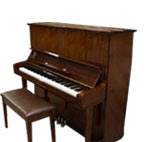Almost no musical work has had such a powerful influence or evoked as much controversy as Igor Stravinsky’s ballet score “The Rite of Spring”. The work’s premiere on May 29, 1913, at the Théatre des Champs-Elysées in Paris, was scandalous. In addition to the outrageous costumes, unusual choreography and bizarre story of pagan sacrifice, Stravinsky’s musical innovations tested the patience of the audience to the fullest. In this edition of Milestones of the Millennium, we explore the history surrounding “The Rite of Spring,” its infamous premiere and its tremendous impact on music ever since.
One of Stravinsky’s most significant collaborators was Serge Diaghilev, director of the Ballets Russes. The two were close working partners for some twenty years, until Diaghilev’s death in 1929. Much of Stravinsky’s most exceptional music, including the score for “The Rite of Spring,” was composed for the productions of Diaghilev. The first collaboration between the two Russians involved the ballet “Les Sylphides,” in which Diaghilev called upon various Russian composers to orchestrate several of Frédéric Chopin’s compositions for piano. “Les Sylphides” is musically innocuous and foretells but little of the coming storm.
Harvard University professor Thomas Kelly suggests that one of the reasons that the Paris premiere of “The Rite of Spring” created such a furor was that it shattered everyone’s expectations. The evening’s program began innocently with a performance of “Les Sylphides.” However, as the follow-up piece, “The Rite of Spring” turned out to be anything but spring-like. One of the dancers recalled that Vaslav Nijinsky’s shocking choreography was physically unnatural to perform. “With every leap we landed heavily enough to jar every organ in us.” The music itself was angular, dissonant and totally unpredictable. In the introduction, Stravinksy called for a bassoon to play higher in its range than anyone else had ever done. In fact, the instrument was virtually unrecognizable as a bassoon. When the curtain rose and the dancing began, there appeared a musical theme without a melody, only a loud, pulsating, dissonant chord with jarring, irregular accents. The audience responded to the ballet with such a din of hisses and catcalls that the performers could barely hear each other.
Backstage at the premiere, Nijinsky shouted at the dancers while Diaghilev tried to suppress a possible riot by flashing the house lights. Stravinsky himself fumed at the audience’s response to his music. If nothing else, the ballet’s premiere managed to instill in the audience the true spirit of the music. As Thomas Kelly states, “The pagans on-stage made pagans of the audience.” Despite its inauspicious debut, Stravinsky’s score for “The Rite of Spring” today stands as a magnificent musical masterpiece of the twentieth century.










